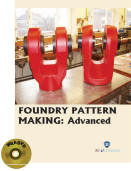Trade and Industrial Education

Foundry Patternmaking: Advanced comprehends various diverse practical and visual skills with knowledge of specialized materials and techniques. A foundry is a workshop that produces metal castings. The making of patterns, called patternmaking is a skilled trade that is related to the trades of tool and die making and mold making. Patterns used in sand casting may be made of wood, metal, plastics or other materials. Patterns are made to exacting standards of construction, so that they can last for a reasonable length of time, according to the quality grade of the pattern being built, and so that they will repeatable provide a dimensionally acceptable casting. This book will introduce the knowledge and skills for those studying and/or working in foundry industry to interpret and convey information in response to workplace requirements.
About this Book
The information in this book consists of basic to core competencies that a person must achieve to be able to manufacture and develop corebox for shell core sand and develop and manufacture gear, conveyor screw and propeller patterns. It also include competency to develop gravity die casting mold used to produce component parts for automotive, track, and allied industries.
About the Foundry Industry
The foundry industry consists of many stages from mining to the actual casting of the metal and iron. While most of the materials used in the foundry industry are mined from the earth as ore and minerals that are heated and liquified, many recycled iron and steel products are also heated and liquidated before being poured into molds and turned into new steel and iron bars. This type of recycling brings scrap yards, automobile salvage yards and neighborhood recycling programs into the foundry industry. Trucking and rail services are also involved in the process of creating new steel from old and discarded steel scrap, as they transport the raw materials to the foundry where the scrap is turned into new steel. While the foundry industry is not responsible for the creation of many finished items, it is responsible for creating the raw castings that are finished by other factories. Once the raw materials have been heated to a liquid and poured into molds, the foundry industry process often requires use of large drop-hammers to pound the hot iron bars into a specific size and shape. Many different steel types and iron types are created by the mixture and addition of certain minerals to the molten iron while it is still in the large cauldrons. Engineering firms have a construction crew or hire a construction company to build the foundry. Engineers work with construction foremen to plan and construct the facility from start to finish. Foundry engineers look at the current setup and structure and determine solutions to meet the customer’s needs within the current facility.